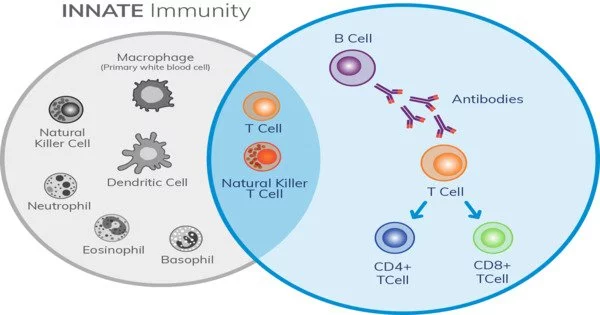Immune tolerance refers to the body’s ability to distinguish and tolerate its own cells and molecules from foreign substances. Immunological tolerance is a state in which the immune system is unresponsive to substances or tissues that would otherwise elicit an immune response in a given organism.
The immune system is intended to defend the body against harmful invaders such as bacteria, viruses, and other pathogens. In contrast to conventional immune-mediated elimination of foreign antigens, it is induced by prior exposure to that specific antigen. It must, however, avoid attacking the body’s own tissues and cells, which could result in autoimmune diseases. Tolerance is achieved by the immune system through a process known as central tolerance and peripheral tolerance.
Central Tolerance:
- This occurs during the development of immune cells in the thymus (T cells) and bone marrow (B cells).
- Immature T cells and B cells undergo a selection process, eliminating those that react strongly against self-antigens (molecules present in the body).
- Cells that pass this selection process become part of the immune repertoire but are tolerant to the body’s own antigens.
Peripheral Tolerance:
- This occurs in the peripheral tissues and involves regulatory mechanisms to prevent the activation of self-reactive immune cells.
- Regulatory T cells (Tregs) play a crucial role in suppressing potentially harmful immune responses. They help maintain immune homeostasis by suppressing the activity of other immune cells.
- Other mechanisms, such as anergy (functional inactivation) and deletion of self-reactive cells, contribute to peripheral tolerance.
Tolerance is classified as either central or peripheral depending on where the state is induced—the thymus and bone marrow (central) or other tissues and lymph nodes (peripheral). The mechanisms by which these types of tolerance are established differ, but the effect is similar.
Immune tolerance is essential for healthy physiology. Central tolerance is the primary mechanism by which the immune system learns to distinguish between self and non-self. Peripheral tolerance is critical for preventing immune system overreactivity to various environmental entities (allergens, gut microbes, etc.).
Deficits in central or peripheral tolerance can lead to autoimmune disease, resulting in syndromes such as systemic lupus erythematosus, rheumatoid arthritis, type 1 diabetes, autoimmune polyendocrine syndrome type 1 (APS-1) and immunodysregulation polyendocrinopathy enteropathy X-linked syndrome (IPEX), as well as asthma, allergy, and inflammatory bowel disease. And immune tolerance during pregnancy is what allows a mother animal to carry a genetically distinct offspring while keeping an alloimmune response at bay enough to prevent miscarriage.
When immune tolerance fails, the immune system may attack the body’s own cells, resulting in autoimmune diseases. Rheumatoid arthritis, lupus, type 1 diabetes, and multiple sclerosis are all examples of autoimmune diseases.
















